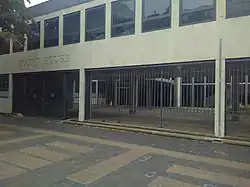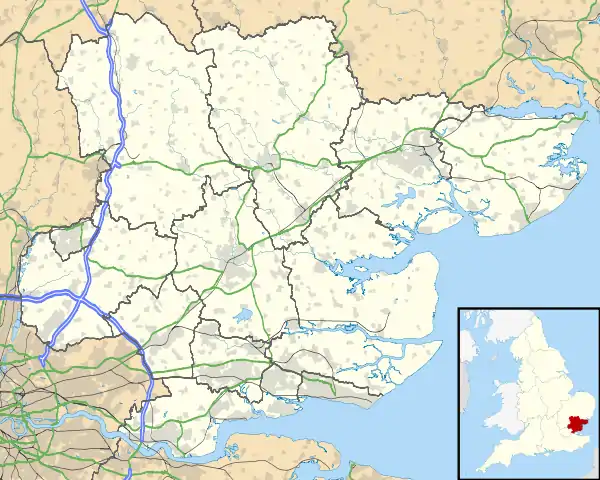| Southend Court House | |
|---|---|
 Southend Court House | |
| Location | Victoria Avenue, Southend-on-Sea |
| Coordinates | 51°32′37″N 0°42′35″E / 51.5437°N 0.7098°E |
| Built | 1966 |
| Architect | Patrick Burridge |
| Architectural style(s) | Modernist style |
 Shown in Essex | |
Southend Court House is a Crown Court venue which deals with criminal cases, as well as a County Court venue, which deals with civil cases, in Victoria Avenue, Southend-on-Sea, England. Located immediately to the south of Southend Civic Centre, it is also the venue for magistrates' court hearings.
History
Until the mid-1960s, the main venue for criminal court hearings in Southend-on-Sea was a courthouse on Alexandra Street. It was first built there for the petty session hearings in 1883, rebuilt in the early 20th century,[1] and then re-built again in 1924.[2] It continued to serve the borough for much of the 20th century.[3] However, as the number of court cases in Southend grew, it became necessary to commission a more modern courthouse. The site selected by the borough council was a vacant site which had previously been occupied by the Commercial School.[4]
The new building was designed by the borough architect, Patrick Burridge, in the Modernist style, built in concrete and glass and was completed in 1966.[5] The design involved an asymmetrical main frontage of 30 bays facing onto Victoria Avenue. On the left of the main frontage, there was a wide opening of 12 bays leading to an inner courtyard and a glass doorway beyond. The building was fenestrated by a series of small square casement windows on both floors. Internally, the building was laid out to accommodate two courtrooms. [6] Following the implementation of the Courts Act 1971, the courthouse became the venue for hearings of the newly designated Southend Crown Court.[7]
The borough council commissioned a bronze sculpture entitled "Leda and the Swan" which was designed by Lucette Cartwright.[8] It was initially placed outside the courthouse but when councillors decided to relocate the sculpture to the civic square there was a backlash from protestors who objected to the sexual nature of the artist's work which depicted the thunder god, Zeus, in the form of a swan, raping a woman.[9] The sculpture was initially moved to the courtyard of the Palace Theatre in Westcliff-on-Sea and but it was later relocated to the mayor's residence where it was placed safely out of view.[10]
Notable court cases have included the trial and conviction of Rick Kerry, in June 2013, for robbery. He leapt from the dock and escaped from the courthouse immediately after sentencing but was later re-captured.[11][12][13]
References
- ↑ Burrows, John William (1909). Southend on Sea and District Historical Notes. John H. Burrows & Sons. p. 226.
- ↑ "Southend Timeline 1860–1879". Retrieved 20 March 2023.
- ↑ The Electrician. Vol. 145. 1950. p. 242.
The Petty Sessions House, Alexandra Street, Southend
- ↑ "Ordnance Survey Map". 1950. Retrieved 20 March 2023.
- ↑ "Court House: Southend-on-Sea: the main stairs and landing". Royal Institute of British Architects. Retrieved 20 March 2023.
- ↑ "Southend". Ministry of Justice. Retrieved 20 March 2023.
- ↑ Courts Act 1971 (Commencement) Order 1971 (SI 1971/1151)
- ↑ Cartwright, Lucette. "Leda and the Swann". Art UK. Retrieved 20 March 2023.
- ↑ "Controversial rape statue in Southend secured in Art UK sculpture database". Basildon, Canvey, Southend Echo. 28 February 2019. Retrieved 20 March 2023.
- ↑ "Mayor gives 'rape' statue a new home". Basildon, Canvey, Southend Echo. 19 June 2008. Retrieved 20 March 2023.
- ↑ "Southend robber flees court after sentencing". BBC News. 21 June 2013. Retrieved 20 March 2023.
- ↑ "Robber escapes from Court". ITV News. 21 June 2013. Retrieved 20 March 2023.
- ↑ "Mugger given eight months for escaping Southend court". Basildon Canvey Southend Echo. 25 July 2013. Retrieved 20 March 2023.